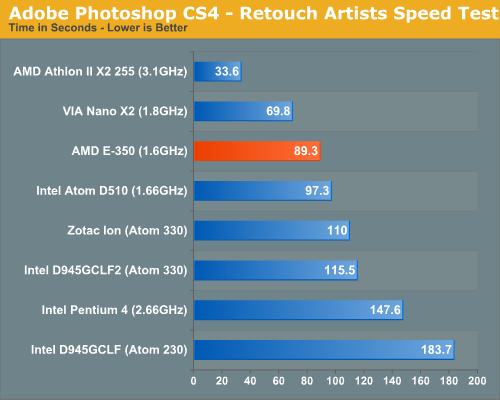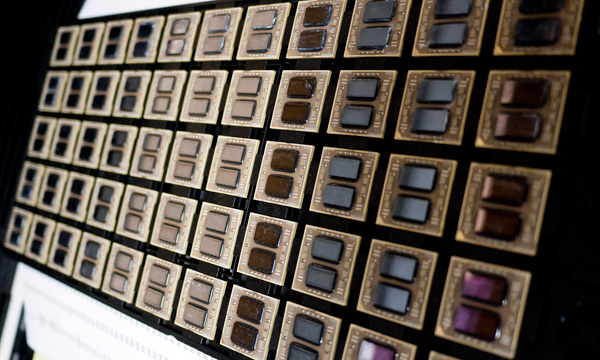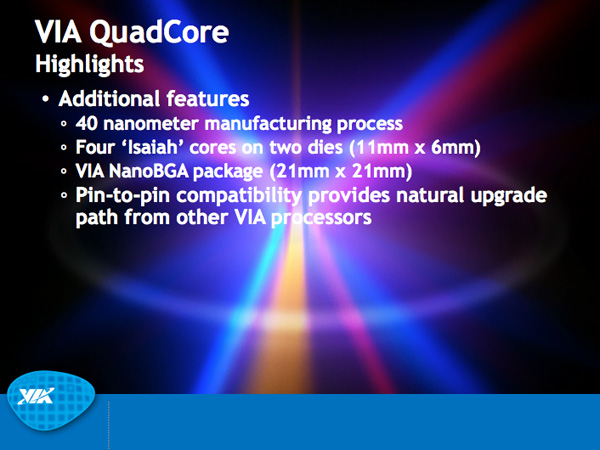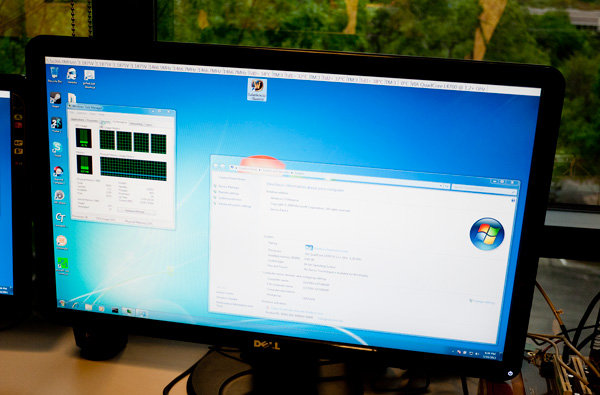VIA's QuadCore: Nano Gets Bigger
by Anand Lal Shimpi on May 12, 2011 3:01 AM ESTTwo days ago I flew out to VIA's Centaur headquarters in Austin, Texas to be briefed on a new CPU. When I wrote about VIA's Dual-Core Nano I expected the next time we heard from VIA about CPUs to be about its next-generation microprocessor architecture. While Nano still holds a performance advantage over Atom and Bobcat, it's still missing a number of key architectural innovations that both Intel and AMD have adopted in their current generation hardware (e.g. GPU integration, power gating).

VIA's dual-core Nano, faster than AMD's E-350 and Intel's Atom
Much to my surprise, the meeting wasn't about VIA's next-generation microprocessor architecture but rather the last hurrah for Nano: a quad-core version simply called the VIA QuadCore.
VIA's QuadCore architecture is nothing too surprising. At a high level the chip is composed of two dual-core die connected by a shared 1333MHz FSB, very similar to the old dual-core Pentium D processors. Each dual-core die has two 1MB independent L2 caches, for a total of 4MB of L2 on-package.

VIA's QuadCore, in production today
Going a little deeper there's an AMD-like 64KB L1 instruction and 64KB L1 data cache per core. The Nano is of course fully 64-bit x86 compatible, supporting up to SSE4. Each core is a 3-issue out-of-order design, giving it a general throughput and performance advantage over Intel's Atom and AMD's Bobcat. Remember that Atom is a 2-issue in-order architecture and Bobcat is 2-issue out-of-order. The wider front end for Nano gives VIA the ability to perform well in more complex workloads.

In the past power consumption has been an issue for VIA's Nano, however the QuadCore is built on a 40nm process which helps reel in power consumption. At 1.2GHz, VIA's QuadCore still carries a 27W TDP. Add another 5W for the integrated graphics chipset and you're talking about 32W, nearly double of AMD's dual-core E-350 Brazos platform. VIA claims that at lower clock speeds it can significantly reduce TDP, however the 1.2GHz QuadCore is the only part being announced today.
VIA is calling the 1.2GHz part a 1.2GHz+ QuadCore since it can use available TDP headroom to overclock itself by up to another two bins (133MHz per bin - 1.46GHz max). The chip doesn't support power gating, just aggressive clock gating.

Like all Nano parts, the QuadCore features a hardware AES encryption engine. VIA has added support for SHA-384 and SHA-512 as well.
Although there are still a considerable number of dual-core platforms sold in the market today, designs with four beefy processor cores seem to be where the world as a whole is headed. With its 2011 15/17-inch MacBook Pro and iMac updates, Apple no longer offers a dual-core option in those systems. By the time we move to 22nm I wouldn't be too surprised if the 13-inch MacBook Pro was quad-core only as well.
VIA moving to four cores makes sense and the QuadCore design was an obvious step. Even Intel used a dual-die approach to make the most of its existing microprocessor design before starting from scratch for Nehalem.
As odd as it sounds, VIA's QuadCore actually has a small but viable position in the market. At 27.5W the TDP is too high for a tablet like the iPad, and its performance will be too low to compete with ultra portable Sandy Bridge designs. What VIA could offer however is a a higher performing alternative to Brazos but at a better price than an ultraportable Sandy Bridge notebook.

The bigger issue VIA has to face is the lack of OEM adoption. The QuadCore will launch with whitebox and motherboard designs, not with slick design wins from companies like ASUS or Samsung. With less than 1% of the x86 market, VIA can't command the sort of attention that Intel or even AMD can. That being said, I do believe there's a small window of opportunity here. A clever OEM could put out a system priced similarly to a Brazos (if not lower than), with better performance based on VIA's QuadCore. I haven't looked at the current state of VIA's graphics drivers but when we previewed the dual-core Nano I came away pleasantly surprised. I suspect there will still be issues there going forward, but I remember something an old friend once told me: there are no bad products, just bad pricing. At the right price, in the right system, VIA's QuadCore could work.











36 Comments
View All Comments
wordsworm - Thursday, May 12, 2011 - link
really, would make a good partnership.tipoo - Thursday, May 12, 2011 - link
Agreed, although I'm not sure VIA's x86 license would carry over in a buyout. In any case, Nvidia is going to be doing some neat things with ARM, with what looks like a cell-like chip in which a high performance ARM core (or more) controls many CUDA cores, that sounds like it has potential.rahvin - Thursday, May 12, 2011 - link
If the Via x86 License was transferable then nVidia would have bought them a year ago when they made all the waves about x86 licenses. All indications are that if Via changes hands again the x86 license goes away. There are also indications that when it changes hands last time Intel added some conditions about how Via could use the license at least that's my opinion. IMO Via's limited themselves to certain market segments that at the time of the last transfer Intel wasn't interested in. This may simply be economics but I also think it's possible that they are contractually limited to those areas from conditions Intel extracted during the last transfer of the Centuar group.Anyway, my main point is that it's pretty common knowledge that if Centaur trades hands again the x86 license is gone making the division worth nothing on the open market. If Via/S3 can't make the business work they will simply evaporate unless they can get the government to force Intel to make the sale possible.
gayannr - Thursday, May 12, 2011 - link
I wonder what AMD is using for their simulations ? i7 ? :)qwertymac93 - Thursday, May 12, 2011 - link
nah, probably magny cours.Prosthetic Head - Thursday, May 12, 2011 - link
AMD will almost certainly be using their own chips. I am a computational chemist and regularly run large simulations on HPC facilities. Most of these use AMD chips. For example the HECToR machine built using Cray XE6 units uses 44,544 cores worth of 12-core AMD Opteron 2.1GHz Magny Cours processors.AMD do very well in the HPC space.
Prosthetic Head - Thursday, May 12, 2011 - link
Oh and the spec of the machines next upgrade has just been confirmed:"The solution supplied will be a 30 cabinet system utilising the next generation AMD Interlagos processor and Cray's Gemini interconnect. The machine will have a projected theoretical peak of 820TF and as such represents a greater than two-fold increase in capability over the current Phase 2b system."
tipoo - Thursday, May 12, 2011 - link
I'll reserve my judgement, but right now I can't see this being competitive at all. Its basically the dual core variant with two dual-core chips glued together, and only minor architectural tweaks. Add in the required graphics that it doesn't have, and its power consumption will be much higher than Brazos as the article says. I can't see a segment it would be better in, its kind of the awkward middle child between processors for ultramobiles and processors for netbooks, it doesn't really fit the bill of either.Interesting chart, are Atoms finally more powerful than a Pentium 4 2.66GHz now? AMD's even more so. Not bad.
L. - Monday, May 23, 2011 - link
And that's without considering that Brazos is going to be 32nm sometime soon -- poor VIA they never could make anything useful could they ?Soulkeeper - Thursday, May 12, 2011 - link
One of the better articles i've read in awhile.Nice to see a small company like via rolling up their sleeves and making cpu's "24 at a time" to compete with the monster intel.
the extra 2 cores + beefed up padlock is very interesting
i'd be interested in seeing how that competes with i7